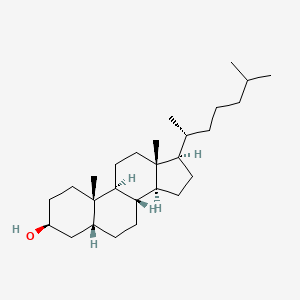| MeSH term | MeSH ID | Detail |
|---|---|---|
| Diabetes Mellitus | D003920 | 90 associated lipids |
| Diabetes Mellitus, Type 2 | D003924 | 87 associated lipids |
| Cataract | D002386 | 34 associated lipids |
| Hypercholesterolemia | D006937 | 91 associated lipids |
| Alcoholism | D000437 | 27 associated lipids |
| Brain Diseases, Metabolic | D001928 | 9 associated lipids |
| Biliary Fistula | D001658 | 13 associated lipids |
| Xanthomatosis | D014973 | 17 associated lipids |
| Xanthomatosis, Cerebrotendinous | D019294 | 14 associated lipids |
Coprosterol
Coprosterol is a lipid of Sterol Lipids (ST) class. Coprosterol is associated with abnormalities such as Cerebrovascular accident, Glycogen Storage Disease Type IV, Coronary Arteriosclerosis, CARDIAC EVENT and Diabetes Mellitus, Non-Insulin-Dependent. The involved functions are known as cholesterol absorption, Death, Sudden, Cardiac, Drug Interactions, Cholesterol Homeostasis and Synthesis. Coprosterol often locates in lipid raft, Tissue membrane, Membrane, Blood and Body tissue. The associated genes with Coprosterol are ABO gene, STN gene, Alleles, Apolipoprotein E gene and TNF gene. The related lipids are saturated fat, campesterol, lathosterol, Sterols and Total cholesterol. The related experimental models are Rodent Model.
Cross Reference
Introduction
To understand associated biological information of Coprosterol, we collected biological information of abnormalities, associated pathways, cellular/molecular locations, biological functions, related genes/proteins, lipids and common seen animal/experimental models with organized paragraphs from literatures.
What diseases are associated with Coprosterol?
Coprosterol is suspected in Coronary Arteriosclerosis, Cerebrovascular accident, Glycogen Storage Disease Type IV, CARDIAC EVENT, Diabetes Mellitus, Non-Insulin-Dependent, Niemann-Pick Diseases and other diseases in descending order of the highest number of associated sentences.
Related references are mostly published in these journals:
| Disease | Cross reference | Weighted score | Related literature |
|---|
Possible diseases from mapped MeSH terms on references
We collected disease MeSH terms mapped to the references associated with Coprosterol
PubChem Associated disorders and diseases
What pathways are associated with Coprosterol
There are no associated biomedical information in the current reference collection.
PubChem Biomolecular Interactions and Pathways
Link to PubChem Biomolecular Interactions and PathwaysWhat cellular locations are associated with Coprosterol?
Visualization in cellular structure
Associated locations are in red color. Not associated locations are in black.
Related references are published most in these journals:
| Location | Cross reference | Weighted score | Related literatures |
|---|
What functions are associated with Coprosterol?
Related references are published most in these journals:
| Function | Cross reference | Weighted score | Related literatures |
|---|
What lipids are associated with Coprosterol?
Related references are published most in these journals:
| Lipid concept | Cross reference | Weighted score | Related literatures |
|---|
What genes are associated with Coprosterol?
Related references are published most in these journals:
| Gene | Cross reference | Weighted score | Related literatures |
|---|
What common seen animal models are associated with Coprosterol?
Rodent Model
Rodent Model are used in the study 'Formation of 7-dehydrocholesterol-containing membrane rafts in vitro and in vivo, with relevance to the Smith-Lemli-Opitz syndrome.' (Keller RK et al., 2004).
Related references are published most in these journals:
| Model | Cross reference | Weighted score | Related literatures |
|---|
NCBI Entrez Crosslinks
All references with Coprosterol
Download all related citations| Authors | Title | Published | Journal | PubMed Link |
|---|---|---|---|---|
| Watne AL and Core SK | Fecal steroids in polyposis coli and ileorectostomy patients. | 1975 | J. Surg. Res. | pmid:1100901 |
| Kraaipoel RJ et al. | Incorporation of H2 18O into 20alpha, 22R-di-OH cholesterol: evidence for an epoxide-diol pathway in the adrenocortical cholesterol side-chain cleavage mechanism. | 1975 | FEBS Lett. | pmid:1102334 |
| Radhakrishnan A et al. | Condensed complexes, rafts, and the chemical activity of cholesterol in membranes. | 2000 | Proc. Natl. Acad. Sci. U.S.A. | pmid:11050164 |
| Böttcher MF et al. | Microflora-associated characteristics in faeces from allergic and nonallergic infants. | 2000 | Clin. Exp. Allergy | pmid:11069568 |
| Yan JL et al. | Microbial transformation of 3-hydroxy-5,6-cyclopropanocholestanes--an alternative route to 6-methylsteroids. | 2000 | Steroids | pmid:11077084 |
| Eganhouse RP and Sherblom PM | Anthropogenic organic contaminants in the effluent of a combined sewer overflow: impact on Boston Harbor. | 2001 | Mar. Environ. Res. | pmid:11125703 |
| Burnett JR et al. | Clinical and biochemical features, molecular diagnosis and long-term management of a case of cerebrotendinous xanthomatosis. | 2001 | Clin. Chim. Acta | pmid:11282095 |
| Quilliot D et al. | Phytosterols have an unfavourable effect on bacterial activity and no evident protective effect on colon carcinogenesis. | 2001 | Eur. J. Cancer Prev. | pmid:11432710 |
| Lin DS and Connor WE | Fecal steroids of the coprolite of a Greenland Eskimo mummy, AD 1475: a clue to dietary sterol intake. | 2001 | Am. J. Clin. Nutr. | pmid:11451716 |
| Sugama S et al. | Frontal lobe dementia with abnormal cholesterol metabolism and heterozygous mutation in sterol 27-hydroxylase gene (CYP27). | 2001 | J. Inherit. Metab. Dis. | pmid:11486904 |
